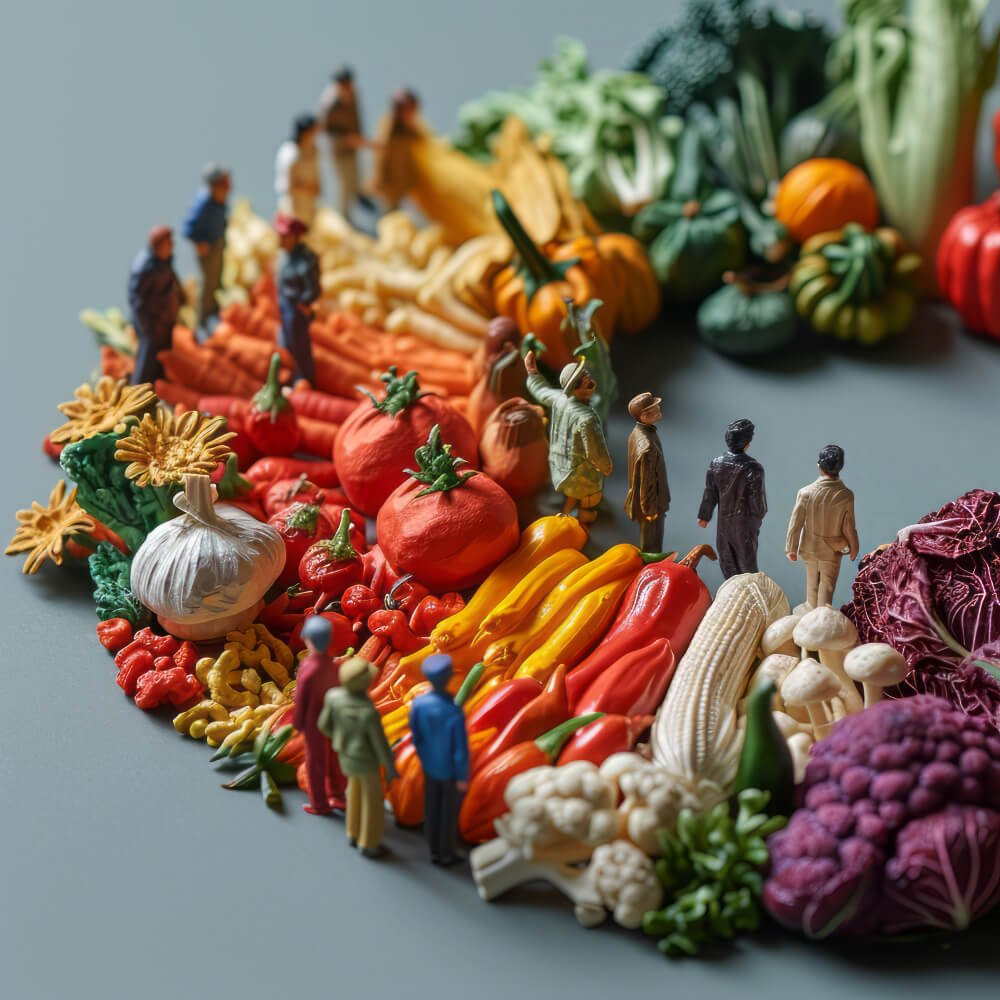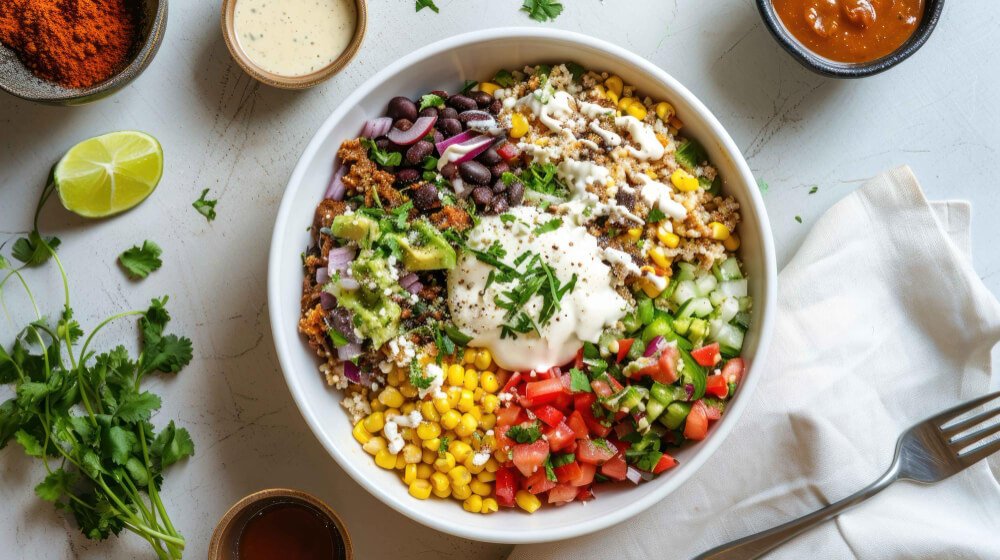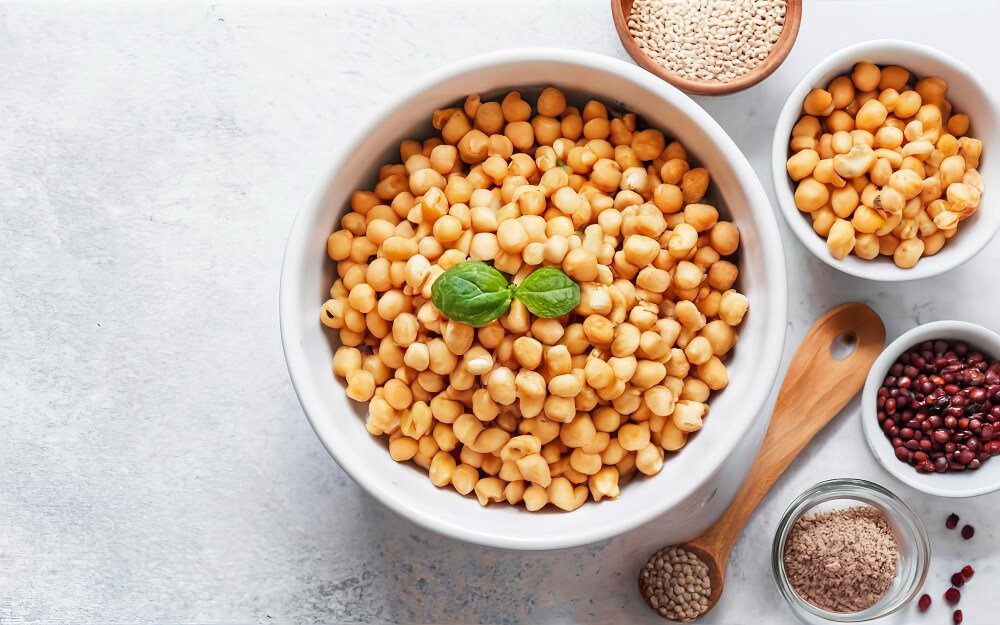Low-GI foods are important to include in your weekly meal plans.
In the modern world, where fast food and processed products dominate our diets, focusing on the quality of the foods we consume is more important than ever.
One key aspect of a healthy diet is our food’s glycemic index (GI).
Low GI foods benefit weight management and are crucial in maintaining overall health and preventing diseases.
In this blog post, we will explore the benefits of incorporating low-GI foods into your daily meals, how they can help both men and women and their impact on certain prevalent diseases. We’ll also provide practical tips on including these nutritious options in your diet, supported by relevant research.
Understanding Low GI Foods
The glycemic index measures how quickly a food raises blood sugar levels after consumption. Foods are ranked on a scale from 0 to 100, with higher values indicating a faster rise in blood sugar.
Low GI foods score 55 or less, meaning they are digested and absorbed more slowly, gradually increasing blood sugar and insulin levels.

Benefits of Low GI Foods
- Improved Blood Sugar Control: Low GI foods help stabilize blood sugar levels and Your Risk Of Developing Type Two Diabetes With This 1 Simple Method, reducing the risk of spikes and crashes. This is particularly beneficial for individuals with diabetes or those at risk of developing the condition.
- Enhanced Weight Management: These foods promote satiety, helping you feel full for longer. This can reduce overall calorie intake and aid in weight loss or maintenance.
- Reduced Risk of Heart Disease: Low GI diets have been linked to lower levels of harmful cholesterol and triglycerides, contributing to a healthier heart.
- Increased Energy Levels: By providing a steady energy source, low GI foods can help prevent the fatigue associated with blood sugar fluctuations.
The Impact of Low GI Foods on Men and Women
Both men and women can reap the benefits of a low GI diet. For men, it can help reduce the risk of obesity and associated conditions like heart disease and type 2 diabetes. For women, low GI foods can be particularly beneficial during pregnancy and in managing conditions like polycystic ovary syndrome (PCOS).
Low GI Foods and Disease Prevention
A low GI diet can play a significant role in preventing and managing various diseases:
- Diabetes: By preventing blood sugar spikes, low GI foods can help manage diabetes and reduce the risk of developing the condition.
- Heart Disease: The positive effects on cholesterol and blood pressure levels contribute to a healthier cardiovascular system.
- Obesity: Low GI foods promote satiety, helping to control appetite and prevent overeating.
Low GI Foods and Weight Loss
Incorporating low-GI foods into your diet can be a powerful tool for weight loss. These foods help regulate appetite and prevent insulin spikes, leading to fat storage. You can create a sustainable eating plan that supports long-term weight management by choosing low GI options.
The Top 10 Low GI Foods for Optimal Health
Incorporating low glycemic index (GI) foods into your diet is a smart strategy for maintaining stable blood sugar levels, managing weight, and reducing the risk of chronic diseases.
Here’s a list of the top ten low GI foods you should consider adding to your eating plan, their nutritional benefits, and supporting research.

One: The Versatile Superfood
Quinoa’s glycemic index score is around 53; quinoa is an excellent choice for individuals looking to manage their glycemic response, including those with diabetes or anyone seeking to maintain stable energy levels throughout the day.
One of the key reasons quinoa is so highly recommended is its high protein content. Quinoa is one of the few plant-based foods that contain all nine essential amino acids, making it a complete protein source. This is particularly beneficial for vegetarians and vegans who may need to pay extra attention to their protein intake.
Additionally, quinoa is rich in fibre, vitamins, and minerals such as magnesium, iron, and B vitamins.
A study published in the Journal of Medicinal Food found that quinoa has potential benefits in managing type 2 diabetes and hypertension due to its low GI and high antioxidant content.
Quinoa is also a versatile grain that can be easily incorporated into various dishes, from salads and soups to breakfast bowls and side dishes. This makes it a convenient option for adding low-GI foods. Furthermore, quinoa’s nutty flavour and fluffy texture make it a popular alternative to rice and other grains.

Two: The Hearty Legume
Lentils can stabilize blood sugar levels. With a glycemic index score ranging from 30 to 52, depending on the variety, lentils are an excellent choice for individuals looking to manage their glycemic response, including those with diabetes or anyone aiming to maintain consistent energy levels throughout the day.
One of the key reasons for recommending lentils is their high protein and fibre content. These nutrients work together to promote satiety, helping to reduce overall calorie intake and support weight management efforts.
Additionally, the fibre in lentils has been shown to have several health benefits, including improving digestive health and reducing the risk of cardiovascular disease. A study published in the Archives of Internal Medicine suggests that a diet high in legumes like lentils can improve glycemic control and reduce the risk of coronary heart disease in patients with type 2 diabetes.
Lentils are also a rich source of essential vitamins and minerals, including iron, folate, and potassium, contributing to overall nutritional well-being. Furthermore, lentils have been linked to a reduced risk of several chronic diseases, such as diabetes and certain types of cancer, likely due to their high nutrient content and antioxidative properties.

Three: The Cholesterol-Lowering Grain
Barley is an excellent choice for individuals looking to manage their glycemic response, including those with diabetes or anyone seeking to maintain stable energy levels throughout the day.
One of the key reasons barley is so highly recommended is its high soluble fibre content, particularly beta-glucan.
Beta-glucan has been shown to have several health benefits, including lowering cholesterol levels and improving heart health.
A study published in the American Journal of Clinical Nutrition found that consuming barley can significantly reduce blood sugar and insulin responses, making it beneficial for those with diabetes.
Besides its heart-healthy benefits, barley has also been shown to improve digestive health.
The barley fibre can aid digestion and promote regular bowel movements, contributing to overall gut health. Furthermore, barley has been linked to a reduced risk of certain types of cancer, such as colorectal cancer, likely due to its fibre content and the presence of antioxidants.
Barley is also a versatile grain that can be easily incorporated into various dishes, from soups and stews to salads and side dishes. It is a convenient option for adding low-GI foods to your diet.

Four: The Round Fiber-Rich Powerhouse
Garbanzo beans, or chickpeas, are often recommended as one of the best low-GI foods due to their numerous health benefits and low impact on blood sugar levels.
With a glycemic index score of around 28, chickpeas are an excellent choice for individuals looking to manage their glycemic response, including those with diabetes or anyone seeking to maintain stable energy levels throughout the day.
One of the key reasons chickpeas are so highly recommended is their high protein and fibre content.
Combining these nutrients helps promote satiety, reducing overall calorie intake and aiding in weight management. Furthermore, the fibre in chickpeas has been shown to have several health benefits, including improving digestive health and reducing the risk of cardiovascular disease.
A British Journal of Nutrition study reported that chickpeas can help improve glucose and lipid metabolism, making them a valuable addition to a diabetes management plan.
In addition to their nutritional benefits, chickpeas are also a versatile food that can be easily incorporated into various dishes, from salads and soups to hummus and curries. This makes them a convenient option for adding low-GI foods to your diet.

Five: The Nutrient-Dense Fruit
Apples have a glycemic index score of approximately 36, and apples are an excellent choice for individuals looking to manage their glycemic response, including those with diabetes or anyone seeking to maintain stable energy levels throughout the day.
One of the key reasons apples are so highly recommended is their rich nutrient content. Apples are a good source of dietary fibre, particularly soluble fibre, which can help regulate blood sugar levels and improve digestion.
They are also packed with vitamins, such as vitamin C, and various antioxidants, including quercetin, which has been shown to have anti-inflammatory and heart-protective properties.
A study published in Nutrition Journal suggests that apples can help reduce the risk of chronic diseases such as heart disease, diabetes, and cancer due to their low GI and high polyphenol content.
The fibre in apples promotes satiety, helping to reduce overall calorie intake and aiding in weight loss. Furthermore, research has shown that regular consumption of apples is associated with a lower risk of cardiovascular disease, likely due to their antioxidant content and cholesterol-lowering effects.

Six: The Antioxidant Powerhouses
Due to their numerous health benefits and low impact on blood sugar levels, berries, including strawberries, blueberries, and raspberries, are often recommended as some of the best low-GI foods.
With glycemic index scores ranging from 25 to 40, berries are an excellent choice for individuals looking to manage their glycemic response, including those with diabetes or anyone seeking to maintain stable energy levels throughout the day.
One of the key reasons berries are so highly recommended is their rich antioxidant content. Berries are packed with vitamins, minerals, and phytochemicals, including flavonoids and anthocyanins, which have been shown to have potent antioxidative and anti-inflammatory properties.
A study published in the Journal of Nutrition found that incorporating berries into the diet can improve insulin sensitivity and reduce inflammation, making them particularly beneficial for individuals with metabolic syndrome or diabetes.
As well as their antioxidative benefits, berries are also a great source of dietary fibre, which aids in digestion and helps maintain a healthy weight by promoting a feeling of fullness.
This fibre content also contributes to their low GI, as it slows down the absorption of sugars into the bloodstream, preventing rapid spikes in blood sugar levels.

Seven: Delicious Potato Goodness
Sweet potatoes’ glycemic index can vary from 44 to 50, depending on the variety and cooking method, positioning them as a healthier alternative to regular potatoes for those managing blood sugar levels.
This makes sweet potatoes an excellent choice for individuals looking to control their glycemic response, including those with diabetes or anyone interested in maintaining stable energy levels throughout the day.
Sweet potatoes are not only beneficial for their low GI; they are also packed with a wealth of nutrients. They are an excellent source of beta-carotene, which the body converts into vitamin A, essential for vision, immune function, and skin health.
Moreover, sweet potatoes provide dietary fibre, which aids digestion and gives a feeling of fullness, supporting weight management efforts. They also contain vitamins C and B6, potassium, and manganese.
Research published in the Journal of Medicinal Food suggests that the high antioxidant content in sweet potatoes, particularly the purple variety, may help improve blood sugar control and reduce oxidative stress in individuals with diabetes.
These sweet wonders have been studied for their health-promoting properties. A study in the journal Food & Function noted that sweet potatoes have anti-inflammatory and antioxidative effects, which can contribute to the prevention of chronic diseases such as cardiovascular disease and cancer. The rich fibre content in sweet potatoes also plays a role in heart health by lowering blood cholesterol levels when consumed as part of a healthy diet.

Eight: The Heart-Healthy Cereal
The glycemic index of oats varies depending on the type, with steel-cut oats having a lower GI (around 42) than rolled oats (around 55).
This makes oats a suitable choice for individuals looking to manage their glycemic response, such as those with diabetes or those aiming to maintain stable energy levels throughout the day.
One of the key nutritional benefits of oats is their high soluble fibre content, particularly beta-glucan. This type of fibre has been shown to have several health benefits, including lowering cholesterol levels and improving heart health.
A study published in the American Journal of Clinical Nutrition found that consuming oats can significantly reduce total and LDL cholesterol levels, risk factors for cardiovascular disease.
Oats have also been shown to improve glycemic control and insulin sensitivity. Research in the Journal of Nutrition and Metabolism demonstrated that incorporating oats into the diet can lead to better blood sugar management in individuals with type 2 diabetes. This is likely due to the slow digestion and absorption of carbohydrates in oats, which prevents rapid spikes in blood sugar levels.

Nine: The Low-Calorie Crunch
Carrots are often recommended as one of the best low-GI foods for their numerous health benefits and low glycemic index.
With a GI score of around 39, carrots have a minimal impact on blood sugar levels, making them an excellent choice for individuals looking to manage their glycemic response, such as those with diabetes or those aiming for stable energy levels throughout the day.
Beyond their low GI, carrots are also highly nutritious. They are a rich source of beta-carotene, a precursor to vitamin A, essential for eye health, immune function, and skin health.
Additionally, carrots are high in fibre, which aids in digestion and can help maintain a healthy weight by promoting a feeling of fullness. A study published in the European Journal of Nutrition highlighted the potential of carrots to reduce the risk of chronic diseases due to their low GI and high nutrient content.
Furthermore, the antioxidants present in carrots, such as beta-carotene and other carotenoids, have been linked to a reduced risk of certain types of cancer and cardiovascular diseases.
Research in the American Journal of Clinical Nutrition has shown that a diet rich in carotenoid-containing foods like carrots is associated with a lower risk of heart disease.

Ten: Creamy Goodness
Plain, low-fat yogurt has a GI score of around 14 to 37, depending on the sugar content. It’s a good source of protein, calcium, and probiotics.
For several reasons, plain Greek yogurt is often recommended as one of the best low-GI foods.
Firstly, it has a low glycemic index score, typically between 11 and 37, depending on the sugar content and brand.
This means that it has a minimal impact on blood sugar levels, making it an excellent choice for those looking to manage their glycemic response, such as individuals with diabetes or those aiming to maintain stable energy levels throughout the day.
In addition to its low GI, Greek yogurt is praised for its high protein content. Protein is known for its satiating properties, helping to keep you feeling full for longer periods, which can aid in weight management.
A study published in the journal “Appetite” found that consuming high-protein snacks like Greek yogurt can reduce hunger and decrease calorie intake at subsequent meals, supporting its role in weight control.
Greek yogurt is a rich source of probiotics and live bacteria that are beneficial for gut health. Probiotics have been linked to various health benefits, including improved digestion, enhanced immune function, and a reduced risk of certain diseases.
A review in the “Journal of the American College of Nutrition” highlighted the potential of probiotics, like those found in Greek yogurt, to contribute to overall health and well-being.
Key Takeaways: Tips for Incorporating Low GI Foods
- Combine Foods Wisely: Pairing low-GI foods with moderate or high-GI foods can help balance the overall glycemic impact of a meal.
- Cooking Methods Matter: How you prepare your food can affect its GI. For example, boiling sweet potatoes instead of baking them can lower their GI.
- Focus on Whole Foods: Opt for whole, unprocessed foods as much as possible, as they tend to have a lower GI than their processed counterparts.
- Pay Attention to Portion Sizes: Even low GI foods can cause blood sugar spikes if consumed in large quantities.
By incorporating these low-GI foods into your diet, you can enjoy various nutritional benefits while managing your blood sugar levels and reducing your risk of chronic diseases.
Conclusion: Embracing a Low GI Lifestyle
Adopting a diet rich in low-GI foods is a simple yet effective way to improve your health and well-being.
By making mindful choices and incorporating these nutritious options into your daily meals, you can enjoy the benefits of stable blood sugar levels, better weight management, and reduced risk of chronic diseases. Start your journey to a healthier lifestyle today by embracing the power of low-GI foods.
Recipe Idea

Grilled vegetable salad with tuna
Ingredients
- 1 Lemon
- 3/4 cup Tuna pieces
- 1/2 cup Fresh mint
- 1 Garlic clove
- 2 Zucchinis
- 2 cup Asparagus
- 1/2 cup Pistachios chopped
Instructions
- Clean the lemon, grate the skin and squeeze out the juice.

- Drain the tuna, but collect the oil. Remove the leaves from the sprigs of mint and place in a high cup with the lemon zest, lemon juice, and tuna oil.
- Add in the garlic and blend until smooth. Season with pepper and salt. Cut the zucchini into slices and sprinkle with salt and pepper.
- Heat the pan and zucchini for 6 minutes, turning halfway. Then cook the asparagus for 4 minutes, turning halfway.
- Place the vegetables in a bowl and add in the marinade; mix gently until covered. To serve, divide veg and tuna between plates and top with chopped pistachio nuts.
Notes
- Contains nuts
- Gluten-free
- Low carb
- Quick and easy meal
Nutrition
Download your FREE Fat Loss Recipe book here.
I appreciate your support.
Disclosure: The construction of this informative post and all of the scientific research for this article were assisted by AI technology. Scientific research for this article was assisted by AI technology.
You can also follow me on YouTube for the latest, science-backed research on health, weight and weight training, and an endless supply of healthy recipes.
